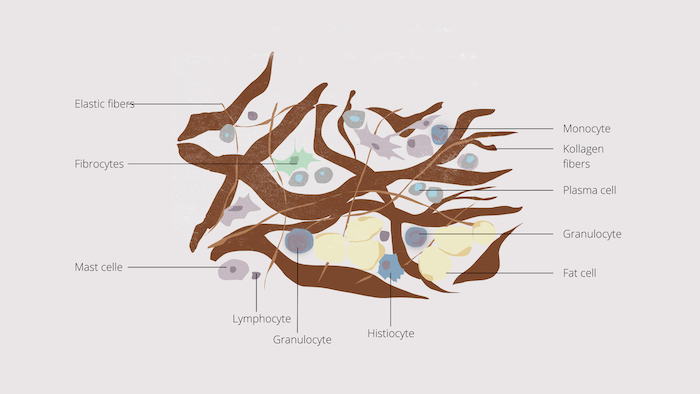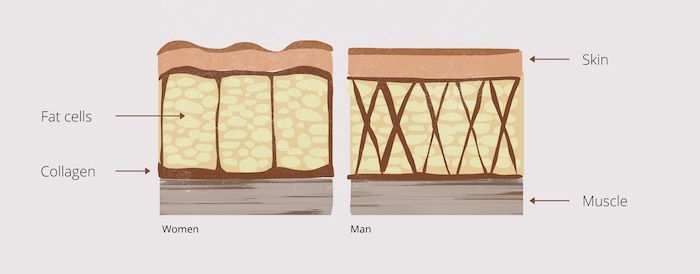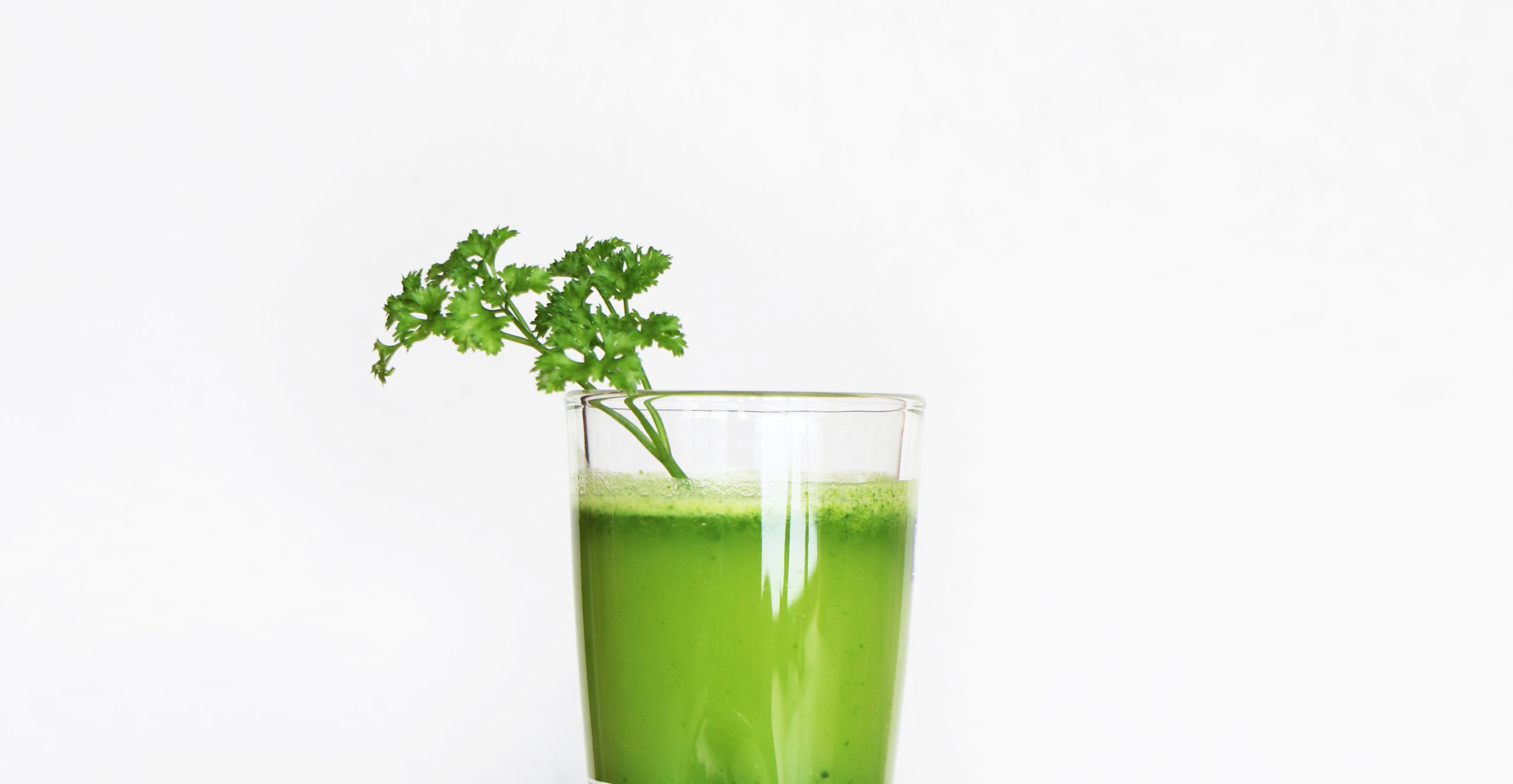Being able to strengthen connective tissue and avoid cellulite is something that interests every woman above 40 (at least). Because unfortunately, women are affected by cellulite more often than men.
But women don’t have to remain helplessly at the mercy of these statistics. In this article, we provide an understanding of how connective tissue is structured, as well as show effective strategies that we can implement in our daily lives to strengthen our connective tissue and avoid cellulite.
What Do We Mean by “Connective Tissue”?
Let’s take a look at connective tissue, starting with the smallest viable unit of our body – the cell. Our body consists of an unimaginably large number of about 80 trillion cells. Depending on the task, cells are structured differently and have different capabilities. If several cells of similar or identical structure join together, this is called tissue. In other words, tissue is an association of similarly developed cells that together can perform specific functions.
There are four types of tissue:
- The epithelial tissue (e.g. skin and mucous membranes)
- Muscle tissue
- Nervous tissue
- Connective and supporting tissue
Structure of the Connective Tissue
A characteristic of connective tissue is its special structure. Here the individual cells are
aren’t quite as densely arranged as they may be in other tissues, but instead lie further apart from one another and are embedded in a watery base substance permeated by fibers, what’s referred to as the “matrix.”.
So the connective tissue consists of 3 parts:
- The connective tissue cells
- The aqueous base substance
- The connective tissue fibers
Connective Tissue Cells
The connective tissue cells are responsible for the metabolic properties of the tissue, and are divided into resident cells and mobile cells:
The resident cells are mainly composed of fibrocytes. They’re essential for the firmness and elasticity of the skin since they produce supporting fibers like collagen and elastin. At the same time, they produce the essential components of the basic aqueous substance, including the well-known hyaluronic acid.
The mobile cells, on the other hand, can move freely in the tissue. They’re formed in the bone marrow and migrate into the connective tissue through the blood vessels. Some of these are also white blood cells, which support the body’s defenses as part of the immune system. The most common free cells are granulocytes, lymphocytes, macrophages, plasma cells, and mast cells.
Aqueous Base Substance
The base substance consists of water and large sugar-protein molecules and is interwoven with various types of fibers. It provides the malleability and lubricity of the tissue.
Connective Tissue Fibers
The connective tissue fibers are divided between the collagenous and elastic fibers:
Collagenous fibers (collagen) are both strong and resilient. As a result of this unique combination, they’re also called the structural protein of connective tissue and skin.
Collagen is the most prevalent protein in the human body, accounting for 30% of total body protein. In particular, it can be found in tendons, ligaments, subcutaneous tissue, bones, and cartilage.
In contrast to collagen fibers, elastic fibers are very stretchy, being made of the protein polymers elastin and fibrillin. Similarly to collagen, elastin fibers are mainly formed in fibroblasts, which are the active fibrocytes. These fibers ensure good elasticity of the skin, among other things.

Function of Connective Tissue
As the name “connective tissue” suggests, it performs a binding function in the human body. It stabilizes joints (ligaments), supports and strengthens the organs of the body like an internal scaffold, transfers power from muscles to bones (tendons), and connects the structures to each other.
Additionally, connective tissue protects against injuries, serves as a water reservoir, takes on metabolic functions, stores metabolic deposits, and plays an important role in the defense reaction against pathogens. And what’s more, the connective tissue acts as calorie storage through the fatty tissue. The soft parts of the connective tissue, which run through the entire body like a network, are also called fasciae.
Connective Tissue Weakness
When we say, “connective tissue weakness,” we’re talking about when the connective tissue loses tone and elasticity. Women are affected by this much more frequently than men because their connective tissue structures are built differently.
In men, the collagen fibers run in a cross-like pattern, but in women, they lie parallel. With this pillar-like structure, the fat cells can push up more easily when the connective tissue starts losing its elasticity. Additionally, the strength of the connective tissue in women is also influenced by hormones (estrogen).

Connective tissue weakness can crop up all over the body. It’s clearly visible from the outside, often in the form of bumps and dents, which are called cellulite, or “orange peel skin.”
Causes
This connective tissue weakness is mainly a natural sign of aging and can be further influenced by genetic predisposition.
In young people, collagen fibers are produced in large quantities, which helps to replace damaged structures more quickly. The older we get, the less collagen the fibroblasts produce and the less collagen the body can store. To maintain the supporting tissue, our body first has to supply collagen to the joints, muscles, and organs. Thus, the skin or subcutaneous tissue is the last place to receive it.
Connective tissue weakness is also influenced by
- Lack of exercise
- A nutrient-poor, high-sugar, and high-fat diet
- Increased fat deposits in the body
- Accumulation of metabolic waste products
Symptoms
Connective tissue weakness manifests itself in:
- Sagging of the outer skin: dimples and stretch marks, especially on the thighs, buttocks, and abdomen.
- Dilatation of blood vessels: spider veins, varicose veins, and hemorrhoids.
- Lowering of organs: uterine prolapse.
Are you interested in gaining a comprehensive understanding of the health benefits of a plant-based diet? Download the curriculum for our Holistic Nutrition Coach training program.
Strengthen Connective Tissue and Avoid Cellulite
Many people feel powerless in the face of weak connective tissue. But we can easily reduce or even prevent this from happening through exercise and a healthy diet.
Movement
“Those who do not move – stick…”
. …that’s what an old proverb says. And recent research proves it right: connective tissue is very sensitive to mechanical stimuli. As soon as the connective tissue cells (the fibrocytes) experience movement or stretching, they’re stimulated to produce new collagen fibers almost explosively and start breaking down old, used-up and agglutinated fibers. Under a scientist’s microscope, fresh collagen fibers look fluffy, soft and elastic, while old and unused collagen fibers look more “matted” and “stuck together.” We can compare these to the fibers of a wool sweater which can be fluffy and soft on a new sweater, or matted after going through a wash that’s too hot.
Fascia researchers all agree: connective tissue needs fresh, fluffy fibers to provide tone and elasticity. Regular exercise makes the connective tissue gradually become firmer, the skin tauter, and fat cells and metabolic deposits push upward less. And the physical exertion also stimulates the hyaluronic acid in the connective tissue to bind more water to itself, which provides additional elasticity.
Some good forms of exercise for this could be walking, jogging, trampolining, swimming, aerobics, yoga, fascia training, and targeted strength training under supervision.
A combination of endurance and strength training is ideal. Endurance exercise stimulates lymph flow and promotes fat burning, which effectively works against metabolic deposits and fat storage. Regular strength training sessions build muscle and tighten connective tissue.
Healthy Diet
The most important question regarding nutrition is: How can we eat in a way that gets as many nutrients to our cells as possible, and that burdens our body as little as possible?
If we eat too many foods that have an acid-forming effect and contain substances that our body can’t metabolize, then the body goes into an excretion crisis and, in its distress, stores metabolic waste products in the form of sticky residues in the connective tissue.
So we’re on the right track with organically grown plant foods. They’re rich in nutrients and give us a large amount of antioxidants, enzymes, biophotons, fiber, minerals, vitamins, and secondary phytonutrients in a natural compound. In addition to this, they’re metabolized alkaline and have a very positive effect on our excretory organs without burdening them. This way, metabolic waste products can be excreted without sticky residues getting stored up in the body.
The best diet is one that’s rich in water, low in salt and fat, and rich in minerals. Cucumbers, celery, wild herbs like goutweed and nettle, and parsley are particularly helpful.

We can support the formation of collagen and a strong connective tissue through:
Vitamin C
This water-soluble vitamin not only helps to prevent premature skin aging as an antioxidant, but it also strengthens connective tissue by acting as an essential cofactor in collagen synthesis in fibroblasts and elastin formation.
Additionally, vitamin C affects the concentration of hyaluronic acid, which binds a lot of water, giving the skin a youthful appearance. Vitamin C also helps protect hyaluronic acid from being broken down too quickly by enzymes.
The foods richest in vitamin C are rose hips, sea buckthorn berries, hibiscus flowers, nettle, parsley, black currants, and peppers.
Vitamin E
This fat-soluble vitamin helps repair any damaged connective tissue structures and has an anti-inflammatory effect.
Green vegetables, wheat germ oil, nuts, and seeds are particularly rich in vitamin E.
Magnesium
Another cofactor of collagen synthesis is magnesium. It’s valuable to include magnesium-rich foods in the diet, especially in childhood or when a wound is healing and new tissues are being formed.
Silicon
Silicon is the trace element for our skin, hair, nails, joint cartilage, and bones. It increases moisture retention, supports the formation of collagen and elastin, and activates the “hydroxylation” enzymes that cross-link collagen fibers.
In food, silicon is present in the form of silicic acid, a compound of silicon and water. In this form, silicon is particularly bioavailable. Foods rich in silicic acid are field horsetail, nettle, dandelion, goutweed, brown millet, cucumber, green juices, celery, and oats.
Zinc
The trace element zinc is also one of the nutrients that’s key for the formation of collagen. It’s a component (or cofactor) of over 200 enzymes and is therefore extremely important in almost all metabolic processes.
Wild herbs, poppy seeds, sesame seeds, pumpkin seeds, buckwheat, and legumes are all rich in zinc.
Amino Acids That Build Connective Tissue
The structural protein collagen consists of long, intertwined protein chains that are mostly composed of the amino acids glycine, proline, and hydroxyproline.
As a complete protein, collagen can be found in animal products like bone broth, meat, fish, chicken, and eggs.
However, the body can also produce collagen itself if enough amino acids are available for this purpose. The amino acids glycine, proline, and hydroxyproline are really important here. Alanine, arginine, aspartic acid, glutamic acid, leucine, and lysine are also valuable, just in smaller quantities.
Some notable sources of plant-based amino acids include legumes, quinoa, hemp seeds, buckwheat, sprouts, seeds, and nuts, as well as wild plants and green leafy vegetables.
Hyaluronic Acid
Hyaluronic acid is a long-chain polysaccharide (multiple sugars) that has the ability to bind large amounts of water. This means that hyaluronic acid provides moisture and elasticity to a lot of different organs, for example, the skin, eyes, and joints. As we age, the hyaluronic acid content in our body decreases.
This process can be influenced by diet in two ways:
- Animal foods like bone broth, meat, or offal contain hyaluronic acid naturally.
- Plant foods contain precursor compounds that can help the body form hyaluronic acid. These include citrus fruits and vegetables like leafy greens, root vegetables, sweet potatoes, parsley, and cilantro.
More Tips for Avoid Cellulite:
- Taking MSM (methylsulfonylmethane): this organic sulfur compound has an activating effect on collagen formation.
- Rubs that contain lemon juice, healing clay, or algae.
- Alkaline baths help to stabilize the acid-base balance and have a purifying effect.
- Sweating in the sauna supports detoxification and the elimination of metabolic waste products and toxins through the skin.
- Alternating between showers and dry brushing stimulates blood circulation in the skin, as well as the movement of lymph fluid and the elimination of metabolic waste products.

Would you like to join our unique, based on nutritional sciences and practice-oriented training program for gaining a high level of health?
We are more than happy to inform you about our training program on our website!






0 Comments